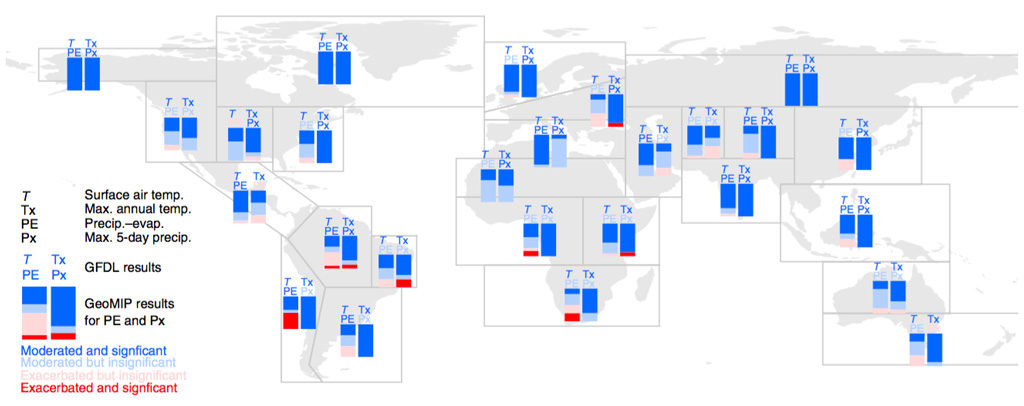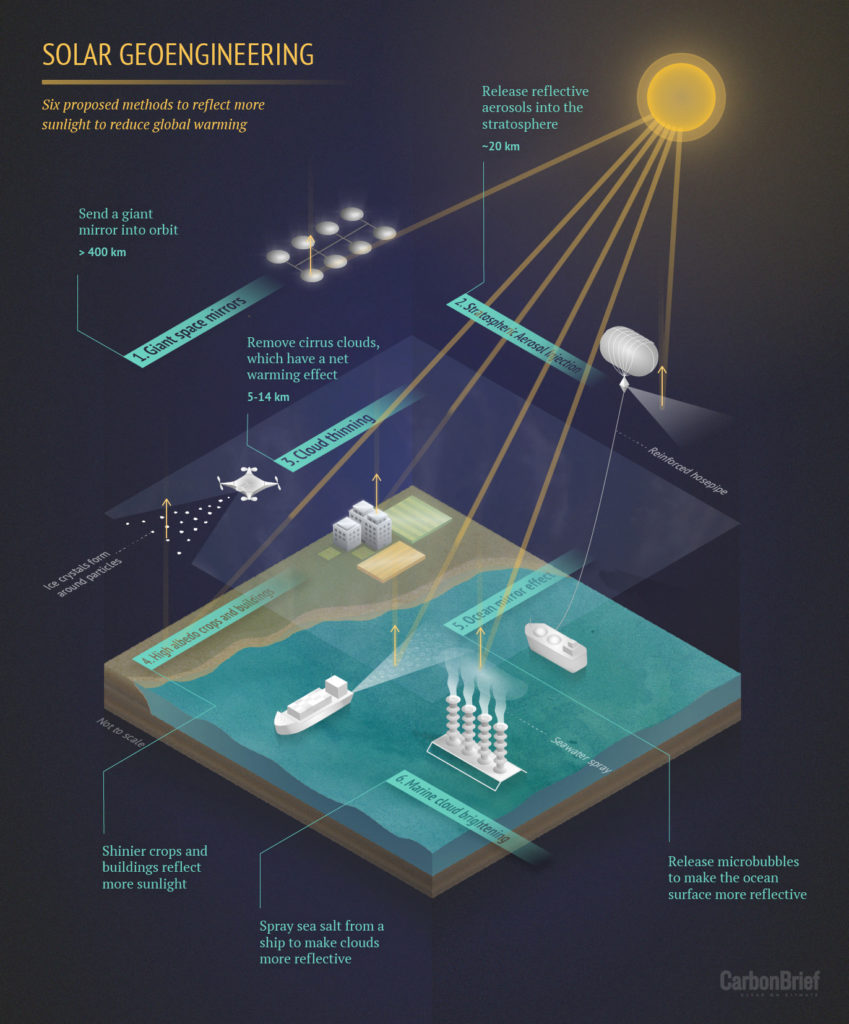
Halving global warming with solar geoengineering could ‘offset tropical storm risk’
Daisy Dunne
03.11.19Daisy Dunne
11.03.2019 | 4:00pmEngineering the climate to reflect away sunlight could halve global warming and offset the risk of increases in tropical storms, new research suggests.
The study finds that an “idealised” case of “solar geoengineering” – a group of hypothetical technologies that aim to lower warming by reflecting the sun’s rays away from the Earth – would not exacerbate extremes in temperature or water availability for most world regions.
The findings stand in contrast to earlier research suggesting that solar geoengineering could, under certain circumstances, cause some regions to face amplified climate impacts.
The research marks an “important step in solar geoengineering research” by looking at climate impacts that “could directly affect society”, one scientist tells Carbon Brief.
However, the study “would have been more policy-relevant” if its modelling technique “represented solar geoengineering using stratospheric aerosols” – rather than an idealised scenario, another says.
Sundown
From removing certain clouds to sending giant mirrors to space, the proposed ideas for solar geoengineering – also known as solar radiation management (SRM) – vary widely in form.
However, they all have the same aim of reflecting incoming sunlight back into space – which could, in theory, slow global temperature rise.
This could protect the world from many of the impacts of global warming. However, it would not directly address rising CO2 levels – which are causing oceans to become more acidic and crops to become less nutritious, among other problems.
The new study, published in Nature Climate Change, focuses on an “idealised” scenario akin to using “stratospheric aerosol injection” – an idea for reflecting sunlight by releasing aerosols into the stratosphere.
This would cool the planet in a similar way to a volcanic eruption. When a volcano erupts, it can send an ash cloud high into the atmosphere. The sulphur dioxide released in the plume combines with water to form sulfuric acid aerosols, which reflect incoming sunlight.
Some researchers have proposed that artificially introducing aerosols into the atmosphere – using a plane or a high-altitude balloon – could have a similar cooling effect.
One concern that has been raised about this idea is that reducing incoming sunlight could impact the water cycle. Specifically, research has suggested that, if solar geoengineering were used to fully offset the warming caused by a doubling of CO2 levels, rainfall could decrease – with some regions being worse affected than others.
The new study looks at a more moderate intervention. It imagines that solar geoengineering is used to offset half of the warming caused by a doubling of CO2 levels. In the video below, study lead author Dr Pete Irvine, a postdoctoral fellow at Harvard University, tells Carbon Brief why the researchers chose to study this scenario.
(The video was shot by science editor Robert McSweeney at the 2018 American Geophysical Union (AGU) fall meeting in Washington, DC.)
Dim view
To conduct the virtual experiment, the research team used models from the Geoengineering Model Intercomparison Project (Geomip) – which is commonly used in solar geoengineering studies – and the high-resolution forecast-oriented low ocean resolution (Hiflor) model, which has been used to study tropical storms.
The researchers did not simulate aerosol release, but rather an “idealised” case of solar geoengineering, Irvine says:
“We have a case where CO2 concentrations have doubled and we turn the sun down by 1%. This is a kind of sketch of how halving warming with solar geoengineering would influence the climate.”
The researchers then investigated how this global dimming would impact annual temperature averages, yearly maximum temperature, global tropical storm intensity, yearly maximum precipitation in a five-day window (a measure of flood risk) and precipitation minus evaporation (a measure of water availability). The researchers studied changes on land and also where people live.
The team focused on precipitation-evaporation rather than rainfall alone because it gives a clearer picture of water availability, says co-author Prof David Keith, leader of the solar geoengineering programme at Harvard University. He says:
“While it seems reasonable to assume that less rain means that things are drier, in fact, what matters more for ecosystems and farmers is water availability: rainfall minus evaporation. Geoengineering reduces rainfall, but it also reduces evaporation by reducing temperatures. So, a decrease in rainfall can be associated with an increase in water availability.”
Global picture
The research finds that using solar geoengineering to halve warming would not exacerbate extremes in temperature, rainfall or water availability for the majority of world regions, when compared to present-day levels.
It finds that, under the solar geoengineering scenario, only 0.5% of the land surface would see a significant amplification of water availability extremes, while a quarter of the land surface would see fewer extremes, when compared to today.
The map below gives an idea how climate extremes could change across the world. On the map “T” represents surface air temperature and “Tx” represents maximum annual temperature. In addition, “PE” represents precipitation-evaporation, a measure of water availability, and “Px” represents maximum five-day precipitation, a measure of flood risk.
The two columns shown beneath the letters correspond to “PE” (left) and “Px” (right). In each column, blue indicates the proportion of results where solar geoengineering “moderates” (or reduces) climate extremes when compared to the present day, while red indicates the proportion of results where solar geoengineering exacerbates climate extremes. Bold colours represent a significant change and pale colours represent an insignificant change.

Global distribution of climate extreme changes (compared to present day) when solar geoengineering is used to halve global warming caused by a doubling of CO2 levels. “T” represents surface air temperature, “Tx” represents maximum annual temperature, “PE” represents precipitation-evaporation, a measure of water availability, and “Px” represents maximum five-day precipitation, a measure of flood risk. The two columns shown beneath the letters correspond to “PE” (left) and “Px” (right). Blue indicates that solar geoengineering “moderates” (or reduces) climate extremes, while red indicates that solar geoengineering exacerbates climate extremes. Bold colours represent a significant change and pale colours represent an insignificant change. Source: Irvine et al. (2019)
The maps shows that parts of South America and southern Africa might see a significant exacerbation of water availability extremes if solar geoengineering is used to halve global warming. In their research paper, the authors say:
“In the few regions where half-solar geoengineering exacerbates climate change, it increases water availability. This stands in contrast to previous studies and commentary that highlighted concerns that solar geoengineering would lead to drought.”
The research team also find that using solar geoengineering to halve global warming would largely offset the impact of rising CO2 levels on the global intensity of hurricanes and typhoons.
The findings suggest that, compared to today, a doubling of CO2 emissions would cause the global intensity of tropical storms to increase by 17.6%. Halving warming with solar geoengineering offsets most of this, the authors say, reducing the increase to 2.4%.
Winners and losers?
The findings “challenge” the idea that “there would inevitably winners and losers” with solar geoengineering, Irvine says in the video below.
The finding that solar geoengineering would not inevitably cause there to be regional winners and losers “should not come as a surprise”, says Prof Doug MacMartin, an engineering researcher not involved in the study from Cornell University. He tells Carbon Brief:
“The paper is particularly important because [it uses] a higher resolution climate model that gives more credible projections for some important variables like precipitation extremes – whereas previous papers often only consider variables such as annual mean temperature and precipitation that don’t encompass many important climate impacts.”
The study is “fully in agreement with what we already know” about solar geoengineering, says Prof Govindasamy Bala, from the Divecha Centre for Climate Change at the Indian Institute of Science. (Bala previously published research looking at the impact of solar geoengineering on rainfall.) He tells Carbon Brief:
“[Solar] geoengineering can markedly diminish global and regional climate change from increasing CO2 concentrations. In most regions, the impacts of climate change can be reduced by geoengineering.”
The research is an “important step in solar geoengineering research”, says Prof Ben Kravitz, an earth and atmospheric scientist at Indiana University and the Pacific Northwest National Laboratory, who was not involved in the study. He tells Carbon Brief:
“I am enjoying the fact that more studies in solar geoengineering are looking at extreme events, impacts like food and water security, and other aspects of climate change that could directly affect society. Studies like these will be an essential part of the knowledge that scientists can provide to decision makers in their deliberations about geoengineering.”
It is worth bearing in mind that the research presents an idealised solar geoengineering scenario, says Prof Alan Robock, a professor of environmental sciences at Rutgers University, who was also not involved in the research. He tells Carbon Brief:
“Because they mimicked stratospheric geoengineering by turning down the solar constant rather than by modeling stratospheric aerosols, they ignored a large number of potential impacts, including more diffuse radiation, heating of the stratosphere and impacts on stratospheric ozone. These latter two factors would change atmospheric circulation as well as affect the potential intensity of tropical cyclones.”
The findings “strengthen the notion that a moderate solar geoengineering application would be highly effective at ameliorating most regional climate changes”, says Dr Anthony Jones, an atmospheric scientist from the UK’s Met Office. He tells Carbon Brief:
“However, the study would have been more policy-relevant if it concentrated on a realistic global warming scenario and represented solar geoengineering using stratospheric aerosols. Nevertheless, this paper should impel policymakers to see solar geoengineering for what it is – a potentially effective method of counteracting regional climate change.”
The results are “interesting” but “do not change the fact that solar geoengineering is a highly contentious issue”, says Prof Sonia Seneviratne, a researcher of climate extremes from ETH Zurich. She tells Carbon Brief:
“Solar geoengineering does not solve the root cause of greenhouse gas induced global warming. This is a similar situation to taking morphine when you are very ill, it will mitigate the pain but it will not cure you – and it may make you addicted.”
Irvine, P. et al. (2019) Halving warming with idealized solar geoengineering moderates key climate hazards, Nature Climate Change, https://www.nature.com/articles/s41558-019-0398-8
-
Halving global warming with solar geoengineering could ‘offset tropical storm risk’


